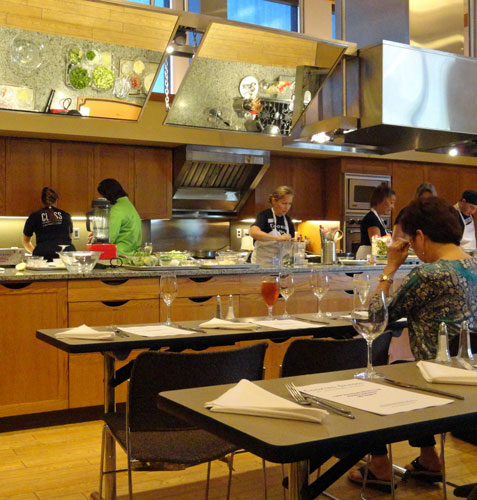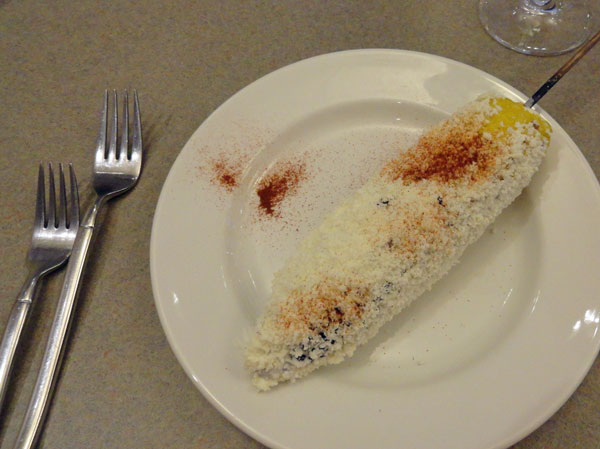 Cookbook author, and Triangle resident, Sandra Gutierrez opened the afternoon’s cooking class at Southern Season with her signature “Hola, y’all” reflecting her own personal fusion of Latin and Southern influences. However, the day’s subject matter would be strictly Latin and the dishes prepared would reflect regional flavors from Central and South America, as found in her latest cookbook Latin America Street Food: The Best Flavors of Markets, Beaches and Roadside Stands from Mexico to Argentina.
Cookbook author, and Triangle resident, Sandra Gutierrez opened the afternoon’s cooking class at Southern Season with her signature “Hola, y’all” reflecting her own personal fusion of Latin and Southern influences. However, the day’s subject matter would be strictly Latin and the dishes prepared would reflect regional flavors from Central and South America, as found in her latest cookbook Latin America Street Food: The Best Flavors of Markets, Beaches and Roadside Stands from Mexico to Argentina.
Gutierrez described how the cookbook came to fruition one day while visiting a Portland, Oregon food truck park with several other food-focused writers. Each person in the her group purchased eight dishes from the food trucks to share. Though several regional flavors were represented by the group’s selections, there was one, lone taco. That solitary Latin course among a global food truck feast inspired Gutierrez. She awoke the next morning, had a conversation with her agent and “Latin America Street Food” was born.
 The cookbook, explained Gutierrez, spans the street food found in twenty countries as a sort of culinary travel log. Twenty percent of the book’s recipes hail from Mexico, which the author describes as the “door to Latin America” from the US. In the book she invites the reader to explore the region and leads us through each country’s flavors. As a bit of historical background, Gutierrez explained to our class how street food became a very important way of life in Latin America during the gas shortages of the 1970s. No longer able to afford the gas to make their way home for lunch each day, street vendors sprang up to serve school children and workers. Because the street food vendors didn’t possess much specialized equipment and worked in limited space, the food is simple and easy to make, often created from a unique family recipe. Gutierrez stressed that the ingredients for the recipes in her book can be found in most any grocery store, as well as Latin American markets in the Triangle.
The cookbook, explained Gutierrez, spans the street food found in twenty countries as a sort of culinary travel log. Twenty percent of the book’s recipes hail from Mexico, which the author describes as the “door to Latin America” from the US. In the book she invites the reader to explore the region and leads us through each country’s flavors. As a bit of historical background, Gutierrez explained to our class how street food became a very important way of life in Latin America during the gas shortages of the 1970s. No longer able to afford the gas to make their way home for lunch each day, street vendors sprang up to serve school children and workers. Because the street food vendors didn’t possess much specialized equipment and worked in limited space, the food is simple and easy to make, often created from a unique family recipe. Gutierrez stressed that the ingredients for the recipes in her book can be found in most any grocery store, as well as Latin American markets in the Triangle.
The first course prepared for the class, a Potato and Chorizo Masa Boat with Avocado-Tomatillo Taco Truck Sauce, found in the chapter titled Tortilla Flats, hails from Mexico. Gutierrez demonstrated the proper preparation of masa, slowing pouring water from a measuring cup with one hand, while working the water in the dry masa harina, forming the dough that would later be shallow fried and shaped into boats to hold the potato and chorizo mixture. “Toppings have a lot to say about how you are,” quipped Gutierrez, further explaining that Latin food is a constant juxtaposition of colors, flavors and textures. Our filled masa boats are topped with crisp iceberg lettuce, finely chopped tomatoes and crumbled Cotija cheese and the creamy, herbaceous Avocado-Tomatillo sauce.
 The next dish, a Peruvian Flounder Ceviche with Corn Nuts, contradicted the stereotype that all Latin food is unhealthy. Gutierrez devotes an entire chapter of her cookbook to lighter courses featuring fresh salads and seafood. Fans of things fried will find recipes for Yuca Fries with Classic Chimichurri, Tostones with Guacamole and Black-Eyed Pea Fritters in the book’s Fried and True chapter. The dish that elicited the most moans of culinary pleasure however, came from the Food on a Stick section. The class seemed mesmerized watching the preparation of Elotes Locos, grilled and skewered corn on the cob, dipped in a mixture of crema and mayonnaise, rolled in Cotija cheese crumbles, then sprinkled with Ancho Chile powder.0
The next dish, a Peruvian Flounder Ceviche with Corn Nuts, contradicted the stereotype that all Latin food is unhealthy. Gutierrez devotes an entire chapter of her cookbook to lighter courses featuring fresh salads and seafood. Fans of things fried will find recipes for Yuca Fries with Classic Chimichurri, Tostones with Guacamole and Black-Eyed Pea Fritters in the book’s Fried and True chapter. The dish that elicited the most moans of culinary pleasure however, came from the Food on a Stick section. The class seemed mesmerized watching the preparation of Elotes Locos, grilled and skewered corn on the cob, dipped in a mixture of crema and mayonnaise, rolled in Cotija cheese crumbles, then sprinkled with Ancho Chile powder.0
We found the final stop on our culinary tour of “Latin America Street Food” in Argentina where dessert took the form of a traditional sandwich cookie, Alfajores, a delightful construction of Dulce de Leche spread between two soft shortbread-like cookies, then edged in coconut shreds. Our culinary journey had reached its end, though more adventures await on the cookbook pages.
Interested in taking the class, meeting the author and/or buying the book? Sandra Gutierrez will teach two more classes at Southern Season (scheduled for November 10 and December 14, 2013) this year featuring recipes from her book, though the dishes will vary from the September 14 class menu. This Wednesday, September 18, Gutierrez will open the Fall season of CHOP NC (Culinary Historians of the Piedmont, North Carolina) at Flyleaf Books (7 – 8:30 pm) for a book talk, tasting and signing event.
